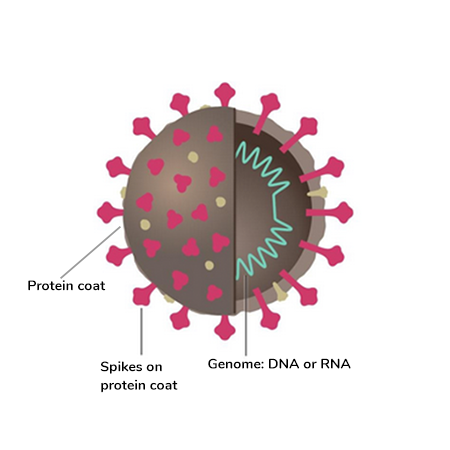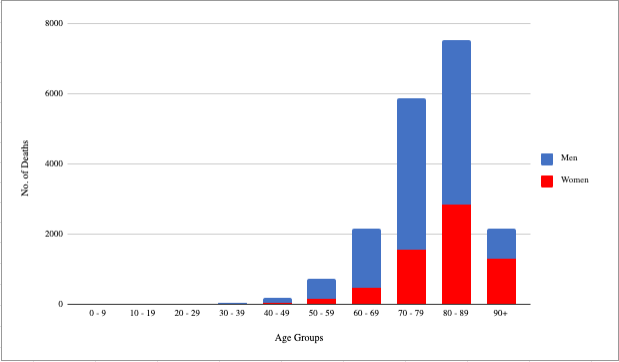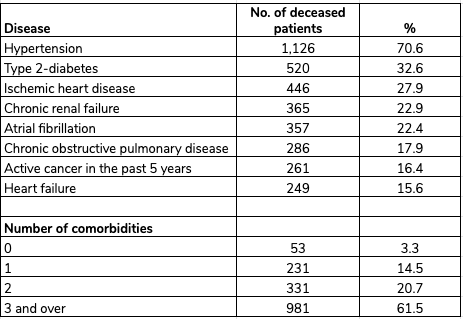Awareness
The present Covid-19 pandemic
Prof. M.C.M Iqbal
Published on Tue, 04/21/2020 - 11:01

Photo by Tedward Quinn on Unsplash
This article is based on information available in the public domain on the Corona virus, which has brought the world to a standstill – an unprecedented phenomenon in the entire history of our planet. Even though millions died during the two World Wars, everyday life was not affected to the extent that we have today. The objective of this article is to provide you with a background on the Corona virus, why it is dangerous, and the importance of following instructions from medical authorities and the government to contain the spread of the virus. We also hope that you would become familiar with some of the technical terms that are being currently used.
Virus and the Genome
What is a virus and is it living? A single virus particle (called a virion) consists of an outer shell made of protein, enclosing and protecting their genome. The genome (see below) is the complete set of instructions for any organism to function. A virus particle is very tiny (20 to 400 nanometers) and cannot be seen through a microscope. Digital images of the virus are made using an electron microscope. The instructions written in the viral genome are very sinister. Once the virus enters our living cells (called infection), it stops the normal functions of the infected cell and hijacks the cell machinery to produce more copies of itself. The cell eventually bursts open and the virus particles are released, which infect new cells initiating a chain reaction. Other than making more copies of itself, within a host cell, it has no other function. Thus, the only characteristic a virus shares with living organisms is they can multiply, and they have defied the question whether they are even living. Sir Peter Medawar, Nobel Laureate, described a virus as “a piece of bad news wrapped in protein”.
The genome of the virus consists of a long molecule called DNA or RNA, which is a long chain of four ‘letters’ of the genetic alphabet. These letters are A, T, G and C for a DNA genome and A, C, U and G for an RNA genome. The letters stand for chemical compounds called bases (Adenine, Thymine, Guanine, Cytosine and Uracil). Small changes can take place in the genome of the virus called mutations. A mutation is a change in the sequence of bases in the DNA or RNA molecule, which can make them more lethal or even harmless. Such changes are always occurring, and it is what contributes to the evolution of life. What makes a mutation more lethal in a virus are changes to the protein surface facilitating their entry into the cells in our body. For example, the lethal viral strains may have something similar to a ‘knife’ on their protein surface with which they can open an entry point into the cells in our body.
Corona viruses
Corona viruses have been with us for a long time. The term Corona comes from the Latin word for ‘crown’ or ‘halo’ due to the club shaped spikes coming from the surface: this is a schematic diagram of a single virus particle.

The corona viruses were first discovered in the 1960s. They caused respiratory infections in humans and up to now seven Coronavirus strains have been identified. Two strains were responsible recently for global outbreaks. In 2002 and 2003 the SARS outbreak caused by SARS-CoV (Severe Acute Respiratory Syndrome Coronavirus), killed 774 people; there were over 8000 infections with a case fatality rate of 9-11%. This virus was spread from humans to humans. In 2012 there was another major disease outbreak caused by another coronavirus MERS-Cov (Middle East Respiratory Syndrome Coronavirus), which killed 884 people. MERS was spread from camels to humans and restricted to the Arabian Peninsula. There are another four coronaviruses that cause seasonal influenza-like illness; these are not deadly as the SARS viruses and cause millions of infections every year. The common cold, we all suffer from in our life, is caused by one of these strains. The seventh Coronavirus, SARS-CoV-2, is the cause of the current pandemic. Within four months it has spread to 180 countries, causing over 2.4 million confirmed cases and over 166,000 deaths.
A new Corona virus strain is born
The present outbreak, caused by a new strain of the Corona virus, was first identified in Wuhan, China in December 2019. All the seven Corona viruses are found in bats, and in the past 100 years each of them made the jump from bats to humans through another animal intermediary host. Scientists have compared the genomes of SARS-CoV-2 with other possible animals. While it has not yet being definitively proved, it is suspected that the jump from animal to humans occurred through an intermediate host. This happened most likely in the ‘wet market’ in Wuhan, where live animals are sold for meat. Being a new Corona virus, there are many unanswered questions.
In January 2020, Chinese and other scientists succeeded in deciphering the complete genome of this new strain of human corona virus and named it SARS-CoV-2. The new Corona virus has a genome (RNA) length of around 30,000 bases, which are responsible for around 30 genes. In comparison, the human genome (DNA) has three billion bases responsible for 22,000 genes (only 2% of the 3 billion bases translate into genes, and the rest are ‘junk’). Deciphering the genome is important to help scientists immediately to develop testing methods to identify infected persons. This they have successfully done, which is indispensable to identify the infected. In the future, they are needed to develop vaccines and design drugs to interfere with the entry of the virus into our cells. The letters in the genome also tells us the new mutations in the genome, and their significance.
The genes of the virus are indeed bad news. They are responsible for sabotaging the activity of the cells they infect, interfering with routine house-keeping activity of our cells, making new copies of the virus, assembling and packaging new virus particles, providing protection from our antiviral proteins. Genes also make the peculiar spikes of the Corona virus. The bad reputation of this Corona virus is due to the changes (mutations) in the new structure of the spike proteins which enables them to efficiently bind and gain entry into our cells. For those who are curious, the first few RNA letters of the Corona virus genome go like this: AUUAAAGGUUU…! These letters can be translated into proteins – the stuff that gets things done in our cells. See the New York Times April 3, 2020 for a more detailed discussion.
Interestingly, the present pandemic was already foreseen in 2015 by geneticists at the University of North Carolina, who were studying the genomes of the Corona virus circulating in bats (Menachery., et al 2015, 2016). They predicted the potential for the re-emergence of a new SARS Coronavirus. It was a matter of time for the correct mutation to occur again in the Coronavirus, which would enable it jump from animals to humans and then to infect humans. Bats are home to a large number of different types of Corona viruses. Just like we have many different types of bacteria in our gut doing no harm to us, these Corona viruses exist peacefully with the bacteria and viruses in the bat. When the virus multiplies in the bat, they accumulate small changes or mutations in their genome.
Scientists suspect that two important mutations occurred in the bat corona virus, which enabled them to cause the present global crises. If not for these mutations the virus would have continued without being noticed. The first mutation modified the ‘spikes’ on the surface of the virus so that they could efficiently bind to the surface of the cells lining our respiratory tract. The virus causing our common cold also uses a similar mechanism. The second mutation was the more drastic and responsible for the present pandemonium: The Corona virus was able to grow a protein, which acted like a knife to cut through other proteins on the surface of our cells in the throat and lungs. This enabled a more efficient entry of the virus into our cells. A deadly virus was born.
Genomic analyses at the Huazhong University of Science and Technology in Wuhan, suggest that the spike protein has a site activated by an enzyme called furin (http://chinaxiv.org/abs/202002.00062; 2020). This enzyme is found in many other human tissues such as the lungs, liver and small intestines. This is bad news since this could mean the virus can attack these organs also, unlike the previous Corona viruses. And unlike the previous Corona viruses this protein binds ten times more tightly to the surface of cells (http://doi.org/ggmtk2).
Why is the virus so dangerous?
The new Coronavirus, SARS-CoV-2, is easily transmitted between humans. There are three major pathways of transmission between humans: (i) Close contact. An infected person can release the small virus particles, when sneezing or talking, which are suspended in the air (aerosols), and infect another, (ii) Larger droplets are released from infected persons when they cough or sneeze, and (iii) Droplets with the virus contaminate surfaces, and the virus is transferred from these surfaces through our hands to our eyes, nose and mouth. The virus particles are able to remain viable, particularly, on stainless steel and plastic surfaces up to 72 hours. From the patients identified positive with the virus, it was found that the average incubation time (period from infection to symptoms appearing) is 5 days and most of the infected persons develop symptoms by 8 to 16 days. These facts are necessary to enforce quarantine or periods of isolation of suspected infectious persons, to prevent further disease transmission. However, all infected persons would not show symptoms, particularly the young with a good immune system (our internal defense against foreign germs). These people can silently bring the virus to our homes and infect the elderly and others who are susceptible. Hence, the determined campaign by the authorities to hunt down all possible infected persons and isolate them.
The general picture is that older people are more susceptible to the disease. The figure below shows the absolute number of deaths by age group, in Italy since the outbreak of the pandemic until 13 April 2020. No deaths were reported yet in younger persons less than 19 years of age, while the age group 20 to 29 had only 7 deaths and the age group 30 to 39 had a total of 39 deaths. It is clearly seen that the mortality picks up from the age group 50 to 59. And, except in the 90+ age group, the men were more susceptible than the women.

Figure. Absolute number of deaths by age groups in Italy since the outbreak of the pandemic until 13 April 2020. These data are regularly updated by the SARS-CoV-2 Surveillance Group in Italy (https://www.epicentro.iss.it/en/coronavirus/bollettino/Report-COVID-2019_13_april_2020.pdf).
Added to this is what is called a comorbidity – the medical term for previous and existing other chronic disease/s. The data from the Italian Health Ministry (see Table below) clearly shows that older patients with more than one chronic disease were fatally struck by the corona virus. These chronic diseases were hypertension, diabetes, ischemic heart disease, chronic renal failure, among others. More the number of chronic diseases, higher was the fatality rate. As we age, we are bound to accumulate chronic diseases. The present Corona epidemic is a stark reminder of the importance of following healthy food habits and exercise in our lives, while avoiding exposure to pollutants, smoking, and drug abuse.
Table. Most common comorbidities observed in SARS-CoV-2 positive deceased patients (sample = 1596) in Italy
(https://www.epicentro.iss.it/en/coronavirus/bollettino/Report-COVID-2019_13_april_2020.pdf)

Bendebury and Shilo Delay in an article in the science magazine Nautilus (April 2, 2020) explain the consequences of chronic diseases and how it weakens our body defenses. Chronic diseases cause damage to our cells, which initiates a response from the body’s immune system. This results in the release of a substance called cytokines, which signal the white blood cells to come to the defense. In addition, there are other chemical substances (called inflammatory molecules) that alter the physiology of blood vessels to support the defense system. The presence of a new aggressive pathogen in the body further complicates the harmonious system in our body leading to fever. This causes further damage disrupting the normal cellular function. Thus, the ongoing inflammation from chronic diseases in different organs and systems is further compounded by a new aggressive pathogen.
This is aptly summarized by Bendebury and Shilo Delay: “For those with multiple chronic conditions, irrespective of their age, infection with SARS-CoV-2 is like tossing a lit match into a powder keg”
Is SARS-Cov-2 a biological weapon?
A conspiracy theory going around is that the Coronavirus escaped from a laboratory where it was developed as a biological weapon. Scientists at the Scripps Research Institute in California looked at the viral genomes of the SARS-CoV-2, its closely related members (SARS, MERS), and viral strains isolated from bats and pangolins. They found that there are small mistakes in the genome suggesting that the virus had undergone natural selection. For example, the virus uses the spikes on its protein coat to bind with the cells in our respiratory tract (it latches on to a receptor called ACE2); however, this interaction between the spike and the receptor was not perfect. Somebody designing a virus would have made a perfect match for a complete infection. Based on these studies the scientists conclude that it is very unlikely the virus was developed in a laboratory with sinister motives.
This also raises a fearful question: can scientists indeed develop a perfect or near perfect virus that can wreak havoc globally? The philosophy of ethics tells us that Science is incapable of telling us what is right and what is wrong. Science did not tell us that exploding the nuclear bomb in Japan was wrong – it only provided us with the basic knowledge of the tremendous energy available within the nucleus of the atom. ‘Scientists’ followed up to make the bomb efficiently. Science should be regarded as a powerful method that can unravel the various phenomena that surrounds us. The efforts by scientists in various laboratories around the world, their readiness to share their discoveries, and how much information has been elicited about the Coronavirus in such a short time, is remarkable. This has enabled the rapid development of tests to determine if we are infected, design vaccines, provide treatments, and help authorities to understand and provide policy guidelines to contain this pandemic. It is an emphatic reminder of the importance of basic sciences and scientists in our lives and the need to invest in science education.
Take-Home Message
So, here is briefly what the latest science can tell us. The disease is called COVID-19. The agent causing the disease is a virus called SARS-CoV-2 (Severe Acute Respiratory Syndrome Coronavirus 2). It is a new strain of Coronavirus that was circulating in bats. It underwent a mutation and possibly infected humans through another animal intermediate. This most likely happened at the live animal market in Wuhan, apparently in November 2019. It is dangerous, unlike the common cold, since it has the capacity to aggressively enter our cells in the respiratory system; this capacity was developed by the second mutation it underwent. It has a higher mortality than the other coronaviruses. It can survive the longest period on plastic and stainless-steel surfaces, up to 72 hours. The average incubation time is 5 days and infected persons develop symptoms by 8 to 16 days. Those older and with other chronic diseases are more susceptible – they can be infected by those carrying the virus but not showing symptoms.
I wish to thank Prof. Athula Sumathipala and Dr. Palitha Abeykoon for their suggestions to improve this article, and Nabeela and Fadil for preparing the figures.
References
- Bazell, R. March 26, 2020 Nautilus
- Bendebury, A and Shilo DeLay, M. (2020). How Covid-19 picks on the weakened. Nautilus April 2, 2020
- Menachery, V.D., et al. A SARS-like cluster of circulating bat coronaviruses shows potential for human emergence. Nature Medicine 21, 1508-1513 (2015).
- Menachery, V.D., et al. SARS-like WIV1-CoV poised for human emergence. Proceedings of the National Academy of Sciences 113, 3048-3053 (2016).
- Nextstrain. This is an open-source project providing a continuously updated view of publicly available data showing the evolution and epidemic spread of the pathogen www.nextstrain.org
- Valencia D N (March 24, 2020) Brief Review on COVID-19: The 2020 Pandemic Caused by SARS-CoV-2. Cureus 12(3): e7386. doi:10.7759/cureus.7386
- Villareal, L.P. (2008). Are Viruses Alive? August 8, 2008. Scientific American. Originally published in December 2004.
- https://www.epicentro.iss.it/en/coronavirus/bollettino/Report-COVID-2019_13_april_2020.pdf
Prof. M.C.M Iqbal
Associate Research Professor
National Institute of Fundamental Studies
Sri Lanka
Email : iqbal.mo@nifs.ac.lk